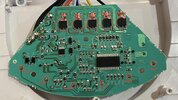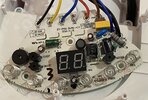D
Danster
Guest
Hi there,
I have ask how can I bypass the touch button on fan Sencor SFE 2340WH, please? I want to of/off fan with smart momentary switch. Below is componets names, maybe with reading errors and photos of con board. Thank for all suggestions.
PS: The best solution will be if i will be able to bypass it by two wires (NO/COM). Like in this post.
Components:
TR1-TR5: HSDQ / BT134-800 / A2040D
MCU1:SOC / SC93F8333M (datasheet link)
U1: PN6007 / M35A17
I have ask how can I bypass the touch button on fan Sencor SFE 2340WH, please? I want to of/off fan with smart momentary switch. Below is componets names, maybe with reading errors and photos of con board. Thank for all suggestions.
PS: The best solution will be if i will be able to bypass it by two wires (NO/COM). Like in this post.
Components:
TR1-TR5: HSDQ / BT134-800 / A2040D
MCU1:SOC / SC93F8333M (datasheet link)
U1: PN6007 / M35A17
Attachments
Last edited by a moderator:




